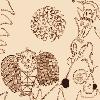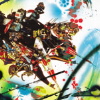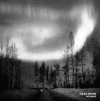- Administrator
- Albums and Singles
 Sufjan Stevens continues to build a deserved amount of attention with his fourth solo album. On Seven Swans,the multi-instrumentalist continues in the trends set forward byearlier releases by creating some powerful pop tunes with a deceptivelyminimal amount of effort. I'm almost taken back to my affinity tohearing Red House Painters in the beginning of Mark Kozelek's career.The lyrics are introspective windows into the author's psyche while themusic is simple and discreet and equally as vulnerable. I truly hopeSufjan doesn't follow the path of the Painters and become an overblownwall of proto-classical rock-by-numbers in a few years time. Theinstrumentation here is perfect for my ears. His musical goal seems tobe to use only what's necessary and not excessively add more that caneither cloud the music or be more than what an independent labelproduction can afford. As a result, acoustic guitar, piano, and hissignature banjo playing are frequently unaccompanied by drums.Lyrically, the album is mostly focused on the themes of relationships,god, and Stevens' relationship to god. As an agnostic, biblicalreferences and the like are completely lost on me, however that's notstopped me in the past from falling in love with music from AmericanMusic Club or Low. While the album is a great listen from start tofinish, I'm reminded of last year's Greetings from Michigan, asthere's that one standout track which strikes an emotional chord withme and will probably end up on numerous mix CDs and radio shows for along time until I get sick of hearing it over and over again. The trackhere is "In the Devil's Territory," where a seemingly simple chordprogression is played by doubled notes in a waltzing time signature.It's somewhat ambiguous songs like that and "Size Too Small," whereSufjan sings about being a best man in a size too small, askingquestions of love and committment that attract me for more listens,while every other song are undeniably pretty treats along the way.Stevens gets assistance from Daniel Smith of Danielson Famile alongwith a bunch of other Smiths, but his live crew is small and simplefrom what I heard on a recent on-air radio interview/in-studioperformance. I personally don't buy into the whole hype surrounding Greetings from Michigan, with respect to plans to record an album for each state, as there's a notable number of references on Seven Swansto Michigan. Enjoy this album now and don't count on something that'llmost likely be regarded as only an overblown rumor years from now.
Sufjan Stevens continues to build a deserved amount of attention with his fourth solo album. On Seven Swans,the multi-instrumentalist continues in the trends set forward byearlier releases by creating some powerful pop tunes with a deceptivelyminimal amount of effort. I'm almost taken back to my affinity tohearing Red House Painters in the beginning of Mark Kozelek's career.The lyrics are introspective windows into the author's psyche while themusic is simple and discreet and equally as vulnerable. I truly hopeSufjan doesn't follow the path of the Painters and become an overblownwall of proto-classical rock-by-numbers in a few years time. Theinstrumentation here is perfect for my ears. His musical goal seems tobe to use only what's necessary and not excessively add more that caneither cloud the music or be more than what an independent labelproduction can afford. As a result, acoustic guitar, piano, and hissignature banjo playing are frequently unaccompanied by drums.Lyrically, the album is mostly focused on the themes of relationships,god, and Stevens' relationship to god. As an agnostic, biblicalreferences and the like are completely lost on me, however that's notstopped me in the past from falling in love with music from AmericanMusic Club or Low. While the album is a great listen from start tofinish, I'm reminded of last year's Greetings from Michigan, asthere's that one standout track which strikes an emotional chord withme and will probably end up on numerous mix CDs and radio shows for along time until I get sick of hearing it over and over again. The trackhere is "In the Devil's Territory," where a seemingly simple chordprogression is played by doubled notes in a waltzing time signature.It's somewhat ambiguous songs like that and "Size Too Small," whereSufjan sings about being a best man in a size too small, askingquestions of love and committment that attract me for more listens,while every other song are undeniably pretty treats along the way.Stevens gets assistance from Daniel Smith of Danielson Famile alongwith a bunch of other Smiths, but his live crew is small and simplefrom what I heard on a recent on-air radio interview/in-studioperformance. I personally don't buy into the whole hype surrounding Greetings from Michigan, with respect to plans to record an album for each state, as there's a notable number of references on Seven Swansto Michigan. Enjoy this album now and don't count on something that'llmost likely be regarded as only an overblown rumor years from now.Read More
- Administrator
- Albums and Singles
 The Horse Hospital has carved out a unique place among London'snumerous arts venues, serving as central headquarters for the moreeccentric fringes of the underground and avant-garde media and culture.They've hosted art exhibitions from the likes of Joe Coleman, MarkRyden, David Tibet and Steven Stapleton, in-person readings from PeterSotos and Adam Parfrey, as well as film screenings, DJ sets and liveperformances from various personages too numerous to mention. Recentlythey've expanded into experimental radio broadcast, hosting afortnightly hour-long show on London's Resonance FM. The show reflectsthe obsession shared by The Horse Hospital's curators for pop-culturemashups, audio distortion, easy listening dimentia and transgressivemusical forms. Far from the gimmicky "The Strokes meet ChristinaAguilera" of Freelance Hellraiser or the bland over-processing ofartists like Knifehandchop, Horse Hospital Radiois a sidereal window into our collective pop-culture imagination,performing a series of variable-speed exorcisms of the extreme ends ofthe musical spectrum. Programmed by the inimitable Mister Sloane, Horse Hospital Radio Volume Threeis a free-form continuous DJ mix that plunges Johnny Mathis into a gaschamber, vents in the laughing gas and sprinkles the whole mess withdialogue snippets from George Ratliff's Hell House. GreenVelvet's rave flashback is slowed down until it resembles a funerealpsychedelic march into a zero-gravity rabbit hole. The siren sounds andthe mix takes a sharp left turn into the joyful drum n' bass insanityof Lightning Bolt and a quick drop into the tweaking aggression ofhardcore dancehall, and it's off into a hypnotic, 10-minute quagmire of18 Cent's "In Da Club" genetically grafted onto the flip instrumentalside of The Neptunes-produced "Grindin'" by The Clipse, pitched downand time-stretched to slow-motion tribal pummeling. Punk godfatherBertie Marshall pipes in with an abbreviated rap about his favoriteprescription painkillers. These post hip-hop mutations come courtesy ofThe Penalty for Harbouring Partisans, partially the work of artist IanJohnstone, John Balance of Coil's new partner in aesthetic terrorism.Jhon Balance can be heard towards the end of the track, blanklyintoning "Nothing's too sad for words." Some uneasy digressions intograting noise and black metal follow, including a stunning marraige ofThe White Stripe's "Seven Nation Army" to the murky sludgecore of SunnO))). Complete with bizarre shout-outs from Michael Jackson and VincentPrice, the whole thing washes over like passing out watching MTV on alethal mix of Quaaludes and DMT. But more than that, it's able toreveal thrilling new dimensions of trash culture and extremeexpression, pointing to a possible new direction for the cultural heirsof the post-industrial milieu.
The Horse Hospital has carved out a unique place among London'snumerous arts venues, serving as central headquarters for the moreeccentric fringes of the underground and avant-garde media and culture.They've hosted art exhibitions from the likes of Joe Coleman, MarkRyden, David Tibet and Steven Stapleton, in-person readings from PeterSotos and Adam Parfrey, as well as film screenings, DJ sets and liveperformances from various personages too numerous to mention. Recentlythey've expanded into experimental radio broadcast, hosting afortnightly hour-long show on London's Resonance FM. The show reflectsthe obsession shared by The Horse Hospital's curators for pop-culturemashups, audio distortion, easy listening dimentia and transgressivemusical forms. Far from the gimmicky "The Strokes meet ChristinaAguilera" of Freelance Hellraiser or the bland over-processing ofartists like Knifehandchop, Horse Hospital Radiois a sidereal window into our collective pop-culture imagination,performing a series of variable-speed exorcisms of the extreme ends ofthe musical spectrum. Programmed by the inimitable Mister Sloane, Horse Hospital Radio Volume Threeis a free-form continuous DJ mix that plunges Johnny Mathis into a gaschamber, vents in the laughing gas and sprinkles the whole mess withdialogue snippets from George Ratliff's Hell House. GreenVelvet's rave flashback is slowed down until it resembles a funerealpsychedelic march into a zero-gravity rabbit hole. The siren sounds andthe mix takes a sharp left turn into the joyful drum n' bass insanityof Lightning Bolt and a quick drop into the tweaking aggression ofhardcore dancehall, and it's off into a hypnotic, 10-minute quagmire of18 Cent's "In Da Club" genetically grafted onto the flip instrumentalside of The Neptunes-produced "Grindin'" by The Clipse, pitched downand time-stretched to slow-motion tribal pummeling. Punk godfatherBertie Marshall pipes in with an abbreviated rap about his favoriteprescription painkillers. These post hip-hop mutations come courtesy ofThe Penalty for Harbouring Partisans, partially the work of artist IanJohnstone, John Balance of Coil's new partner in aesthetic terrorism.Jhon Balance can be heard towards the end of the track, blanklyintoning "Nothing's too sad for words." Some uneasy digressions intograting noise and black metal follow, including a stunning marraige ofThe White Stripe's "Seven Nation Army" to the murky sludgecore of SunnO))). Complete with bizarre shout-outs from Michael Jackson and VincentPrice, the whole thing washes over like passing out watching MTV on alethal mix of Quaaludes and DMT. But more than that, it's able toreveal thrilling new dimensions of trash culture and extremeexpression, pointing to a possible new direction for the cultural heirsof the post-industrial milieu.Read More
- Administrator
- Albums and Singles
 My one true test for any soundtrack or "music from" compilation is whether it can stand alone from the subject matter it was written for. Otherwise, it makes little sense to release it on its own, as the value of having "that music from that one scene" must be incredibly low. Enter the Kadane brothers' EP of music from the film Hell House, and for the most part they pass the test. Unfortunately, some of the tracks are just sketches — as they should be for a soundtrack — and do not blossom into full-fledged compositions.
My one true test for any soundtrack or "music from" compilation is whether it can stand alone from the subject matter it was written for. Otherwise, it makes little sense to release it on its own, as the value of having "that music from that one scene" must be incredibly low. Enter the Kadane brothers' EP of music from the film Hell House, and for the most part they pass the test. Unfortunately, some of the tracks are just sketches — as they should be for a soundtrack — and do not blossom into full-fledged compositions.
Without a reference point in a film that I haven't seen these tracks fall by the wayside, and at a mere eighteen minutes, it's hard to see this as anything but a companion piece of merchandise. However, some of the longer and complete compositions captivate my imagination completely. Left to its own devices and with only a title to set off the chain reaction, my mind comes up with plenty of scenery and atmosphere to allow these tracks to run around and play. "Hell" doesn't sound like my version of it, but it does convey the emotions of someone suffering through a period of genuine strife. There is a beauty to the feeling of loss that drapes the track and its simple guitar structures, and I immediately felt the hairs on my neck rise. There's guitar and banjo in a lovely waltz on "Alex," and "Speaking in Tongues" is chilling ambience with a playfully nuanced shock value that strikes when least expected. "Christy" and "Sex Before Marriage," no doubt meant for scenes close to each other in the film, felt cold and distant, and did not hold my attention for long. The last two tracks, though, "Harvest" and "Wrestling," are what hold the whole thing together. They are the most full-fledged, most descriptive, and most charming, particularly the trumpet by Bob Weston on the latter. Matt and Bubba Kadane could easily make a career of this, and Pleximusic is growing a nice little garden of indie rock film scores. Truth be told, however, I'd much rather reach for their other music in Bedhead or The New Year than this, despite the fine moments I found within.
Read More
- Administrator
- Albums and Singles
 Mantra of Love marks the second instance that the Acid MothersTemple have drawn their primary inspiration from the traditional folkmusic of the Occitan region of France. The first was 2000's La Novia,a moderately successful attempt at scaling back the band's usualbombast to create a hypnotic side-long group harmonization thatrespectfully paid tribute to their European forbears. However, itcertainly wasn't a very satisfying release for hardcore fans of theAcid Mothers, entirely devoid as it was of the band's trademarkmulti-layered cacophony of reverbed electric guitars and screamingsynthesizers. With Mantra of Love, Makoto Kawabata and companyattempt a marriage of heaven and hell: merging an Occitanian trad-folkpiece to their visceral guitar shredding and hallucinogenic symphoniesof rock n' roll noise. The album consists of two tracks. The first, "LaLe Lo," is a trance-inducing song consisting of no lyrics other thanthe melodic glossolalia of the title, repeatedly sung in the cyclicalstyle that seems de rigeur for Occitanian folk. Cotton Casino takes thelead with her sonorous falsetto, sounding more like Renate Knaup fromAmon Duul II with every successive release. As usual with AMT, reverband delay pedals are turned way past eleven, creating an ocean ofdebris and sonic squall that ripples out from every vocal refrain andstrum of the acoustic guitar. These noisy tendencies seem ever slightlymore sedate than usual on Mantra of Love, a continuation of the trend towards cleanly produced studio efforts begun on 2002's Univers Zen ou de Zero a Zero.The track is gently hypnotic until about the seven-minute mark, atwhich point Makoto Kawabata unleashes a majestic guitar storm ofparticularly defocused fury. Seemingly capable of playing ten wildlydifferent and entirely unrelated guitar parts at once, Makoto's soloingcreates a complex web of cosmic shredding that begs for deconstructionand analysis. The track wanders through several more movements ofrelative quiet juxtaposed with overwhelming thunderousness, finallyfloating up to space on galactic streamers of Hawkwind-esque KORGfuckery. It might be culturally irresponsible, but it's massivelyentertaining. The second track is "L'Ambition dans le Miroir" (for whatit's worth, Babelfish translates this as "The Ambition in the Mirror"),a 15-minute addendum to the first track, beginning in synth-heavy spaceterritory not unlike Atem-era Tangerine Dream, quickly joined byCasino's gleeful chanting before expanding into planet-crushingKrautrock. Although it takes zero risks and does nothing to expand theAMT sound repertoire, Mantra of Love does the trick for now.
Mantra of Love marks the second instance that the Acid MothersTemple have drawn their primary inspiration from the traditional folkmusic of the Occitan region of France. The first was 2000's La Novia,a moderately successful attempt at scaling back the band's usualbombast to create a hypnotic side-long group harmonization thatrespectfully paid tribute to their European forbears. However, itcertainly wasn't a very satisfying release for hardcore fans of theAcid Mothers, entirely devoid as it was of the band's trademarkmulti-layered cacophony of reverbed electric guitars and screamingsynthesizers. With Mantra of Love, Makoto Kawabata and companyattempt a marriage of heaven and hell: merging an Occitanian trad-folkpiece to their visceral guitar shredding and hallucinogenic symphoniesof rock n' roll noise. The album consists of two tracks. The first, "LaLe Lo," is a trance-inducing song consisting of no lyrics other thanthe melodic glossolalia of the title, repeatedly sung in the cyclicalstyle that seems de rigeur for Occitanian folk. Cotton Casino takes thelead with her sonorous falsetto, sounding more like Renate Knaup fromAmon Duul II with every successive release. As usual with AMT, reverband delay pedals are turned way past eleven, creating an ocean ofdebris and sonic squall that ripples out from every vocal refrain andstrum of the acoustic guitar. These noisy tendencies seem ever slightlymore sedate than usual on Mantra of Love, a continuation of the trend towards cleanly produced studio efforts begun on 2002's Univers Zen ou de Zero a Zero.The track is gently hypnotic until about the seven-minute mark, atwhich point Makoto Kawabata unleashes a majestic guitar storm ofparticularly defocused fury. Seemingly capable of playing ten wildlydifferent and entirely unrelated guitar parts at once, Makoto's soloingcreates a complex web of cosmic shredding that begs for deconstructionand analysis. The track wanders through several more movements ofrelative quiet juxtaposed with overwhelming thunderousness, finallyfloating up to space on galactic streamers of Hawkwind-esque KORGfuckery. It might be culturally irresponsible, but it's massivelyentertaining. The second track is "L'Ambition dans le Miroir" (for whatit's worth, Babelfish translates this as "The Ambition in the Mirror"),a 15-minute addendum to the first track, beginning in synth-heavy spaceterritory not unlike Atem-era Tangerine Dream, quickly joined byCasino's gleeful chanting before expanding into planet-crushingKrautrock. Although it takes zero risks and does nothing to expand theAMT sound repertoire, Mantra of Love does the trick for now. Read More
- Administrator
- Albums and Singles
 Subject to Change Without Notice is the marriage of all-out sonic assault and the total respect of brevity in an effort to destroy anything in the path. My brains were tapioca and my eardrums numb at the end of this third release from Cleveland's Keelhaul, and while not a pleasurable experience in itself, that's definitely not a negative thing.Hydra Head
Subject to Change Without Notice is the marriage of all-out sonic assault and the total respect of brevity in an effort to destroy anything in the path. My brains were tapioca and my eardrums numb at the end of this third release from Cleveland's Keelhaul, and while not a pleasurable experience in itself, that's definitely not a negative thing.Hydra Head
Not a great thing, though, as there are moments I could have done without, but this definitely got my head moving in a thrash-like motion again after all these years. There is a sense of humor in these songs—any band that names a song "Carl vs. the 10,000 LB Shadow" must have one—but unlike other bands who are using the metal genre as a punchline, Keelhaul are honest and relentless in their pursuit of aggression. Even though they sometimes let the music extend past its usual short stance to the five or eight-minute-plus mark, there was never a moment where I felt like this music was going on longer than it should. That said, the band's strength is in their instrumentation, not the raging screamed vocals that already sound like fifteen other bands. Not that the vocals are unnecessary or particularly horrid: I just returned for repeat listens more on tracks that did not feature them. Keelhaul are incredibly talented musicians, and every moment on the CD, even those that sound sloppy or disorganized, comes off as an entirely calculated move. The songs all blend together, with nary a moment to come up for air, and I imagine their live show is very similar, with the band catching everyone off-guard by starting with the lights turned up and people still finding their seats or a good place to stand. I used to view hardcore and metal and all their sub-genres (doom, speed, shred, goth, etc.) as dying breeds, where no one was creating anything original for them to maintain themselves. Keelhaul have changed my opinion, and though I was not overwhelmed by the music they made on this record, I would listen to future releases in the hope that they've continued to evolve.
Read More
- Administrator
- Albums and Singles
 Even though this 45-minute long EP doesn't have the words "Bliss Out"printed anywhere, consider this to be Volume 18 of Darla's Bliss Outseries. Manual's Jonas Munk is joined by friend Jess Kahr, and the twohave set the mood of peace and serenity by vast keyboard sounds andvery, very slow movement. A more appropriate term might be "drift out,"as the music is like a beat-less version of the other Manual releaseswith similar synth sounds and simple melodies. It will surely findwelcome ears on anybody who has been following Munk through hisrecordings, both as Manual and with Limp on Morr and the EP on StaticCaravan. It is ambient, in the sense that it makes for great backgroundmusic, but it's not until track five, "Burn," that other sonic,non-musical elements (crickets in this case) are introduced that make aworld of difference. For me, it's elements like the faint sound ofrain, bugs, waves, or whatever plus the right mix of everything thatmakes groups like Mirror perfect the art of quiet music for deeplistening. Without a little bit of bite in the mix, the musicdangerously borders on easy listening. It continues similarly withfaint bells in the following "ICA," and by the final track, "It's Nighton Planet Earth...," the music actually begins to immitate the soundsof the waves coming in off the water. I know this sounds nitpicky, butthere's something about the visual theme that seems to disturb me. Itfeels awkwardly mismatched, as palm tree photos at sunset resemblegeneric postcards or that Mac icon for iPhoto. While they're nice tolook at, I'm not sold on it matching the mood Munk's music has alwaysevoked: as to me, the appropriate absence of unnecessary instrumentsconjures visuions of emptier, more sparse places than this borderlinestock photography. Regardless, it's probably one of the best Bliss Out editions.
Even though this 45-minute long EP doesn't have the words "Bliss Out"printed anywhere, consider this to be Volume 18 of Darla's Bliss Outseries. Manual's Jonas Munk is joined by friend Jess Kahr, and the twohave set the mood of peace and serenity by vast keyboard sounds andvery, very slow movement. A more appropriate term might be "drift out,"as the music is like a beat-less version of the other Manual releaseswith similar synth sounds and simple melodies. It will surely findwelcome ears on anybody who has been following Munk through hisrecordings, both as Manual and with Limp on Morr and the EP on StaticCaravan. It is ambient, in the sense that it makes for great backgroundmusic, but it's not until track five, "Burn," that other sonic,non-musical elements (crickets in this case) are introduced that make aworld of difference. For me, it's elements like the faint sound ofrain, bugs, waves, or whatever plus the right mix of everything thatmakes groups like Mirror perfect the art of quiet music for deeplistening. Without a little bit of bite in the mix, the musicdangerously borders on easy listening. It continues similarly withfaint bells in the following "ICA," and by the final track, "It's Nighton Planet Earth...," the music actually begins to immitate the soundsof the waves coming in off the water. I know this sounds nitpicky, butthere's something about the visual theme that seems to disturb me. Itfeels awkwardly mismatched, as palm tree photos at sunset resemblegeneric postcards or that Mac icon for iPhoto. While they're nice tolook at, I'm not sold on it matching the mood Munk's music has alwaysevoked: as to me, the appropriate absence of unnecessary instrumentsconjures visuions of emptier, more sparse places than this borderlinestock photography. Regardless, it's probably one of the best Bliss Out editions.Read More
- Administrator
- Albums and Singles
 Records parading as ethnic albums tend to piss me off; there are veryfew exceptions to this fact. Unless the album is a field recording initself or an earnest attempt at perserving old music in a modern world,the music fails and sounds forced. Fortunately Ver Tanzt?does not fall to such symptoms and emerges as an exhilarating andpainfully beautiful blend of modern and old sound. Anyone that haslistened to a soundtrack from a movie about Jewish life is probablyfamiliar with all the elements of European Jewish music—it is lush,staggered, melodically exotic, and somehow steeped in the feeling ofimprovisation. No matter how well the arrangements come together,there's always a feeling that it's the musicians making it happen thatway, not that composition itself; it simply couldn't have been plannedthat way, it's just too lovely. Black Ox Orkestar run the gamut fromhyper tunes full of blood-pumping rhythms and grin-producing melodiesto the heart-wrenching guitar playing of disaster and rememberance.It's interesting that the group has decided to include a quote that,though I'm not entirely sure of it, references Zionism and the internalconflict between having two homes: one that always moves and one wherea temple once stood. While there is nothing inherently political aboutthe music (though I can't understand the language that is sometimessung), the duration of the album renders real the spirit of conflict,joy, and pain. It is in this way that the group succeeds; the album,despite linguistic and cultural differences, sounds human and iseffective for that reason. The music sounds honest and the use ofJewish musical roots doesn't sound forced or gimmicky—it is earnest andpowerful. I think this band has managed to explain to me why so manygroups fail at employing ethnic sources in their music; it's all just agimmick half the time meant to draw upon the alien and seductive natureof a foreign music without bothering to go through the pains of feelingthe sounds and instruments and making them the source of learning andhumanity that they are.
Records parading as ethnic albums tend to piss me off; there are veryfew exceptions to this fact. Unless the album is a field recording initself or an earnest attempt at perserving old music in a modern world,the music fails and sounds forced. Fortunately Ver Tanzt?does not fall to such symptoms and emerges as an exhilarating andpainfully beautiful blend of modern and old sound. Anyone that haslistened to a soundtrack from a movie about Jewish life is probablyfamiliar with all the elements of European Jewish music—it is lush,staggered, melodically exotic, and somehow steeped in the feeling ofimprovisation. No matter how well the arrangements come together,there's always a feeling that it's the musicians making it happen thatway, not that composition itself; it simply couldn't have been plannedthat way, it's just too lovely. Black Ox Orkestar run the gamut fromhyper tunes full of blood-pumping rhythms and grin-producing melodiesto the heart-wrenching guitar playing of disaster and rememberance.It's interesting that the group has decided to include a quote that,though I'm not entirely sure of it, references Zionism and the internalconflict between having two homes: one that always moves and one wherea temple once stood. While there is nothing inherently political aboutthe music (though I can't understand the language that is sometimessung), the duration of the album renders real the spirit of conflict,joy, and pain. It is in this way that the group succeeds; the album,despite linguistic and cultural differences, sounds human and iseffective for that reason. The music sounds honest and the use ofJewish musical roots doesn't sound forced or gimmicky—it is earnest andpowerful. I think this band has managed to explain to me why so manygroups fail at employing ethnic sources in their music; it's all just agimmick half the time meant to draw upon the alien and seductive natureof a foreign music without bothering to go through the pains of feelingthe sounds and instruments and making them the source of learning andhumanity that they are.Read More
- Administrator
- Albums and Singles
 He possesses the unkempt street-hustler looks of Vincent Gallo, thepsychotic vulnerability of Syd Barrett, the spooked lonesomeness ofSkip Spence, the instrumental dexterity of Robin Williamson, the naïvesincerity of Tiny Tim, and a voice that sounds like a cross betweenMarc Bolan's early T. Rex warble and the evocative wail of KarenDalton. After his superlative debut Oh Me Oh My...,many were quick to heap praise on Devendra Banhart, hailing the 23-yearold singer-songwriter as a peerlessly original voice. With such obviousmusical precedents for Banhart's intimate, acoustic songcraft, thisadulation seems a bit overstated. Despite what has been said, DevendraBanhart hasn't reinvented the wheel. He has, however, used hisconsiderable lyrical and melodic gifts to create a handful ofidiosyncratic recordings that speak volumes for his songwriting talent.Oh Me Oh My... was immediately distinctive not only because ofBanhart's quavering vocal delivery and incredible fingerstyle, but alsobecause of its willfully low-budget recording aesthetic; the songs wereself-recorded live-to-tape on sub-par cassette recorders, Dictaphonesand answering machines. Two years on, Devendra Banhart has achieved amodicum of success, championed by Michael Gira, with a home on hisYoung God label. Although Banhart and Gira could easily have opted foran artificially studied recreation of the low-fidelity distortion andtape hiss of the demo reel, the right choice was made on Rejoicing in the Handsto present the performer in a simple, clean studio recording. Thetracks on this new album sound every bit as live and spontaneous as theOh Me Oh My... sessions, but the technical advantages of thestudio recording highlight every velvety pluck of the guitar stringsand every nuanced vibration of Devendra's labored vocals. Because thesesongs are refreshingly free of extraneous debris and contain onlyminimal, unobtrusive backing, Rejoicing is a marvelous showcasefor Banhart's songs and performances. Each track is a miniaturemasterpiece; few exceed the three-minute mark, but each has theimmediacy and resonance of déjà vu, as if Banhart was pulling from somevast collective-subconscious archive of archetypal sing-along folkmelodies. His lyrical themes are fascinating as always, strangere-combinations of dime-store mysticism, humorous reverie and the oddfanciful passage of surreal wordplay. On the title track, he is joinedby the legendary Vashti Bunyan, the elusive songstress who recorded theacid-folk classic Just Another Diamond Day and promptly disappearedfrom view. Their lovely duet is an affectionate homage to the placidsimplicity of the 60's British folk revival. -
He possesses the unkempt street-hustler looks of Vincent Gallo, thepsychotic vulnerability of Syd Barrett, the spooked lonesomeness ofSkip Spence, the instrumental dexterity of Robin Williamson, the naïvesincerity of Tiny Tim, and a voice that sounds like a cross betweenMarc Bolan's early T. Rex warble and the evocative wail of KarenDalton. After his superlative debut Oh Me Oh My...,many were quick to heap praise on Devendra Banhart, hailing the 23-yearold singer-songwriter as a peerlessly original voice. With such obviousmusical precedents for Banhart's intimate, acoustic songcraft, thisadulation seems a bit overstated. Despite what has been said, DevendraBanhart hasn't reinvented the wheel. He has, however, used hisconsiderable lyrical and melodic gifts to create a handful ofidiosyncratic recordings that speak volumes for his songwriting talent.Oh Me Oh My... was immediately distinctive not only because ofBanhart's quavering vocal delivery and incredible fingerstyle, but alsobecause of its willfully low-budget recording aesthetic; the songs wereself-recorded live-to-tape on sub-par cassette recorders, Dictaphonesand answering machines. Two years on, Devendra Banhart has achieved amodicum of success, championed by Michael Gira, with a home on hisYoung God label. Although Banhart and Gira could easily have opted foran artificially studied recreation of the low-fidelity distortion andtape hiss of the demo reel, the right choice was made on Rejoicing in the Handsto present the performer in a simple, clean studio recording. Thetracks on this new album sound every bit as live and spontaneous as theOh Me Oh My... sessions, but the technical advantages of thestudio recording highlight every velvety pluck of the guitar stringsand every nuanced vibration of Devendra's labored vocals. Because thesesongs are refreshingly free of extraneous debris and contain onlyminimal, unobtrusive backing, Rejoicing is a marvelous showcasefor Banhart's songs and performances. Each track is a miniaturemasterpiece; few exceed the three-minute mark, but each has theimmediacy and resonance of déjà vu, as if Banhart was pulling from somevast collective-subconscious archive of archetypal sing-along folkmelodies. His lyrical themes are fascinating as always, strangere-combinations of dime-store mysticism, humorous reverie and the oddfanciful passage of surreal wordplay. On the title track, he is joinedby the legendary Vashti Bunyan, the elusive songstress who recorded theacid-folk classic Just Another Diamond Day and promptly disappearedfrom view. Their lovely duet is an affectionate homage to the placidsimplicity of the 60's British folk revival. - Read More
- Taylor McLaren
- Albums and Singles
 "Hey, yo, Abilities, man. Yo, I got a little something I gotta getoff my chest right here. A'ight, dig this, man: I'm sick of all thesepunk motherfuckers in this rap game, youknow'msayin? I'm sayin' thesefools steppin' up to us, knowin' they shit is straight GAHbage... youknow what I'm talkin' about: E&A don't play that shit, man."And there you have it: the first twenty seconds of "Act Right", less acouple of DJ Abilities' scratched responses. How many cliches can youcount? Well, a good half of this album isn't much better. In theinterest of saying something nice, however, Eyedea is a darned goodfreestyler, and his partner is lightning-quick on the crossfader. Onstage, they're clever and nimble and their technique is impressive, andif they still battle these days, they're probably worth seeing in thatcontext. Sadly, that's not what you get on E&A; instead,you mainly get to listen to juvenile you-suck rhymes and fag jokes fromthe comfort of your living room, where there presumably isn't anOOOOH-ing crowd around to convince you that cracks about trading headfor "creative juices" are witty. Oh, and then there are some pornosamples, and some tedious choruses, and Abilities scratches up some"FUNKY!"s and "WE GON' KEEP IT RAW!"s at a zillion miles a second tokeep the kids excited. If you've ever messed around with turntables,you'll admire his chops, but since his partner on the mic onlyoccasionally shuts up about how great they are (to say how much itsucks to get a job, for example, before bragging that he's never hadone), you'll also frequently wish that E&A was aninstrumental effort. Which is too bad, because at his best, Eyedea islike the Yngwie Malmsteen of MCs, and his vocals can mesh brilliantlywith Abilities' zany beats and scratching: "One Twenty" is terrifichead-nodding music for about half of its running length, and it's justone of several kamikaze rhymes on the disc. So much of it is somud-ditch dumb, though, that it's hard to sit around and wait for thegood tracks. They try to go out on a thoughtful, angsty note with theReznor-rap of "Glass" (TIP: Try not to be too surprised by the "shattering" metaphor.), but it's really too late by that point. Go looking for their recently-released Road Mix(23 minutes of standout moments from their shows, an edited version of"One Twenty" that doesn't overstay its welcome, and a frank discussionof the Smurfs that's funnier than anything on E&A) instead of wasting your time on this one.
"Hey, yo, Abilities, man. Yo, I got a little something I gotta getoff my chest right here. A'ight, dig this, man: I'm sick of all thesepunk motherfuckers in this rap game, youknow'msayin? I'm sayin' thesefools steppin' up to us, knowin' they shit is straight GAHbage... youknow what I'm talkin' about: E&A don't play that shit, man."And there you have it: the first twenty seconds of "Act Right", less acouple of DJ Abilities' scratched responses. How many cliches can youcount? Well, a good half of this album isn't much better. In theinterest of saying something nice, however, Eyedea is a darned goodfreestyler, and his partner is lightning-quick on the crossfader. Onstage, they're clever and nimble and their technique is impressive, andif they still battle these days, they're probably worth seeing in thatcontext. Sadly, that's not what you get on E&A; instead,you mainly get to listen to juvenile you-suck rhymes and fag jokes fromthe comfort of your living room, where there presumably isn't anOOOOH-ing crowd around to convince you that cracks about trading headfor "creative juices" are witty. Oh, and then there are some pornosamples, and some tedious choruses, and Abilities scratches up some"FUNKY!"s and "WE GON' KEEP IT RAW!"s at a zillion miles a second tokeep the kids excited. If you've ever messed around with turntables,you'll admire his chops, but since his partner on the mic onlyoccasionally shuts up about how great they are (to say how much itsucks to get a job, for example, before bragging that he's never hadone), you'll also frequently wish that E&A was aninstrumental effort. Which is too bad, because at his best, Eyedea islike the Yngwie Malmsteen of MCs, and his vocals can mesh brilliantlywith Abilities' zany beats and scratching: "One Twenty" is terrifichead-nodding music for about half of its running length, and it's justone of several kamikaze rhymes on the disc. So much of it is somud-ditch dumb, though, that it's hard to sit around and wait for thegood tracks. They try to go out on a thoughtful, angsty note with theReznor-rap of "Glass" (TIP: Try not to be too surprised by the "shattering" metaphor.), but it's really too late by that point. Go looking for their recently-released Road Mix(23 minutes of standout moments from their shows, an edited version of"One Twenty" that doesn't overstay its welcome, and a frank discussionof the Smurfs that's funnier than anything on E&A) instead of wasting your time on this one.Read More
- Taylor McLaren
- Albums and Singles
 As it turns out, Bi-Conicals of the Rammellzeeisn't the guy's first full-length: Tri-Eight squeezed out two editionsand an instrumental version of this one late last year, though it lookslike the two albums were recorded more or less concurrently. Gomma,however, appears to have gotten the better pile of tapes out of thedeal, as the variety of producers on Bi-Conicals provides arange of sounds that is sorely lacking from DJ Kensei's beatwork here.Instead, the Japanese hip-hop and house maestro puts together aframework of synth noises that you probably heard too much of duringWax Trax!'s heyday, and while there's nothing much wrong with the MeatBeat bleeping of "Soldiers" or the KMFDM-style riffage on "I BeRamm:Ell:Zee:Zee", their familiarity draws attention to how thin andrepetitive some of the mixes are; a similar problem comes up when thevocals are so drenched in effects that they're practicallyunintelligible. Meanwhile, Ramm's usual style of delivery, a berserkmatching up of broken and rejigged cliches with surreal streetnarrative, succumbs to what I hope is just lousy improvising on "In theBack of the Caddy Shack", saddling an almost funky backing track with apathetic, and largely one-sided, conversation with a twenty-dollarwhore. In still other cases, relatively solid tracks are derailed byidiotic choruses or painful samples. With bad production decisions allaround, only a couple of cuts manage to avoid feeling twice as long asthey need to be: the title track's energetic (and only slightlyprocessed) vocals don't hew too closely to the simple and heavy mainrhythm, but they fit well with the anthemic chorus, and "New Meaning"opens the disc with some fun gurgling sounds and some of the mostmelodic vocoder work I've heard in a while. Even so, right on down tothe guest guitarists, everybody on this album has done betterelsewhere.
As it turns out, Bi-Conicals of the Rammellzeeisn't the guy's first full-length: Tri-Eight squeezed out two editionsand an instrumental version of this one late last year, though it lookslike the two albums were recorded more or less concurrently. Gomma,however, appears to have gotten the better pile of tapes out of thedeal, as the variety of producers on Bi-Conicals provides arange of sounds that is sorely lacking from DJ Kensei's beatwork here.Instead, the Japanese hip-hop and house maestro puts together aframework of synth noises that you probably heard too much of duringWax Trax!'s heyday, and while there's nothing much wrong with the MeatBeat bleeping of "Soldiers" or the KMFDM-style riffage on "I BeRamm:Ell:Zee:Zee", their familiarity draws attention to how thin andrepetitive some of the mixes are; a similar problem comes up when thevocals are so drenched in effects that they're practicallyunintelligible. Meanwhile, Ramm's usual style of delivery, a berserkmatching up of broken and rejigged cliches with surreal streetnarrative, succumbs to what I hope is just lousy improvising on "In theBack of the Caddy Shack", saddling an almost funky backing track with apathetic, and largely one-sided, conversation with a twenty-dollarwhore. In still other cases, relatively solid tracks are derailed byidiotic choruses or painful samples. With bad production decisions allaround, only a couple of cuts manage to avoid feeling twice as long asthey need to be: the title track's energetic (and only slightlyprocessed) vocals don't hew too closely to the simple and heavy mainrhythm, but they fit well with the anthemic chorus, and "New Meaning"opens the disc with some fun gurgling sounds and some of the mostmelodic vocoder work I've heard in a while. Even so, right on down tothe guest guitarists, everybody on this album has done betterelsewhere.Read More
- Administrator
- Albums and Singles
 Wading out of the woods and into the snow with a sound all their own,Tulsa Drone cause a range of emotions to well up on their powerfuldebut. Guitar/bass/drums/hammered dulcimer is not a combination onehears everyday, and as soon as the slight strangeness of it all faded Isettled in for whatever came next. Lo and behold, they have somethinghere, as this is the most unique and powerful music I have heard inmonths. It puts me in a place of complete wonder, like a little boystepping into a new experience like flying on an airplane for the firsttime. Tulsa Drone have been using trains in their promotional postersrecently, and to me that's extremely appropriate, as their music is adrifter's: hopping train car to train car looking for work in the nexttown, trying desperately to improve a station of life that was down andout to begin with. The Drone in their name is a bit of a misnomer tome, as there is no real drone in this music, no constant that echoes inand out on itself that continues for minutes. That's not a complaint,though, as they've certainly manufactured some fine moments on theirfirst recording. The melodic beginnings of "Chiaroscuro" are stirring,with production heavy on the bass side, and a genuine feel for thedramatic. As the guitars flare, the bass and dulcimer rise to meetthem, then all tumble like lovers together back to the base. "Vendetta"steps up the dulcimer to main instrument status, letting everythingbuild around it, with Spanish guitar and arpreggios painting thepicture of the score that needs settling. Occasionally there are hornsor other sounds added for a little spice or variation, but for the mostpart the music is the same core. I found it fascinating that they foundso many different approaches with the same instruments, and so manythemes to operate under. Some hear "drone" and think "boring." Ifnothing else Tulsa Drone prove that wrong, but at their best the createa new horizon to look towards.
Wading out of the woods and into the snow with a sound all their own,Tulsa Drone cause a range of emotions to well up on their powerfuldebut. Guitar/bass/drums/hammered dulcimer is not a combination onehears everyday, and as soon as the slight strangeness of it all faded Isettled in for whatever came next. Lo and behold, they have somethinghere, as this is the most unique and powerful music I have heard inmonths. It puts me in a place of complete wonder, like a little boystepping into a new experience like flying on an airplane for the firsttime. Tulsa Drone have been using trains in their promotional postersrecently, and to me that's extremely appropriate, as their music is adrifter's: hopping train car to train car looking for work in the nexttown, trying desperately to improve a station of life that was down andout to begin with. The Drone in their name is a bit of a misnomer tome, as there is no real drone in this music, no constant that echoes inand out on itself that continues for minutes. That's not a complaint,though, as they've certainly manufactured some fine moments on theirfirst recording. The melodic beginnings of "Chiaroscuro" are stirring,with production heavy on the bass side, and a genuine feel for thedramatic. As the guitars flare, the bass and dulcimer rise to meetthem, then all tumble like lovers together back to the base. "Vendetta"steps up the dulcimer to main instrument status, letting everythingbuild around it, with Spanish guitar and arpreggios painting thepicture of the score that needs settling. Occasionally there are hornsor other sounds added for a little spice or variation, but for the mostpart the music is the same core. I found it fascinating that they foundso many different approaches with the same instruments, and so manythemes to operate under. Some hear "drone" and think "boring." Ifnothing else Tulsa Drone prove that wrong, but at their best the createa new horizon to look towards.Read More

